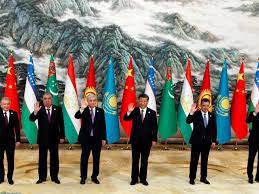Bradley Jardine & Edward Lemon
On May 18, Chinese President Xi Jinping held a lavish ceremony in the ornate Tang Paradise theme park in Xian, the heart of the ancient Silk Road, for five visiting Central Asian presidents who had arrived for the inaugural China-Central Asia summit. Conspicuously, the summit took place at the same time as the G7 meeting of wealthy nations in Hiroshima. Commenting on the two summits, China’s state-run Global Times claimed that the “G7 speaks the language of an outmoded Cold War mentality” while the Xian summit focused on the “promotion of cooperation and inclusiveness”.
In his welcoming remarks, Xi hailed the summit as signalling “a new era of China-Central Asia relations”. Xi said that “China is ready to help Central Asian countries strengthen capacity building on law enforcement, security and defence in an effort to safeguard peace in the region”. The summit resulted in a string of economic agreements signalling that China is again open for business after two years of COVID-19 border restrictions.
While China consolidates its hegemony in Eurasia, it is also promoting a viable competitive vision to the current United States-led order. Yet it is presenting itself as an alternative leader not just to the US, but also to Russia, which it aims to gradually displace from Central Asia. China has grown into the largest economic actor in Central Asia. Total Chinese investments in the region ballooned from $40bn in 2020, to over $70bn by the end of 2022. Russia, which accounted for 80 percent of the region’s trade in the 1990s, now accounts for less than two-thirds of Beijing’s trade.
Lurking beneath these big numbers is a growing asymmetry between China and Central Asia. In 2020, an estimated 45 percent of Kyrgyzstan’s external debt, and 52 percent of Tajikistan’s was owed to China. Meanwhile, 75 percent of Turkmenistan’s exports depend on Chinese consumers. The growing debt burdens have been linked to high-level corruption scandals and have resulted in political instability, also undermining Beijing’s credibility. Indeed, Sinophobia has become relatively widespread in Central Asia, particularly in Kazakhstan and Kyrgyzstan. According to survey data, 30 percent of Kazakhs and 35 percent of Kyrgyz have a negative view of China. Protests against China’s rising role in the region, perceived by some as taking jobs from locals, polluting the environment, and part of a broader strategy to “colonise” the region, have been on the rise. According to our data, 241 protests related to China took place in Kazakhstan from January 1, 2018 to June 30, 2021, although more than half were related to an ongoing protest by relatives of those detained in Xinjiang’s camps.
Some of these protests have turned violent. After the Kyrgyz government was ousted in October 2020 following flawed elections, about 300 locals stormed the Ishtamberdi mine operated by China’s Full Gold Mining, chasing off 132 Chinese workers who were forced to spend the night in a snowy forest. A mob of 100 people also barricaded a group of 35 Chinese businessmen within their hotel in Bishkek. Amid the growing backlash to China’s extreme policies in Xinjiang towards Uighurs and ethnic Kazakhs and Kyrgyz, and the wider Sinophobia in the region, Beijing has solicited support for its policies from Central Asian governments.
While Kyrgyzstan offered a statement of support in June 2019, it declined, along with Kazakhstan, to sign a letter to the United Nations backing Beijing’s position the following month. But in October 2022, Uzbekistan and Kazakhstan voted to block a UN investigation into China’s human rights abuses in Xinjiang. The issue was also notably absent from the talks in Xian last month. In the first two decades after the collapse of the Soviet Union in 1991, China opted to primarily interact with Central Asia through the Shanghai Cooperation Organisation (SCO), which also includes Russia as a member. But the Xi Jinping era has seen China increasingly creating its own mechanisms to work with its western neighbours. The Xian summit, hosted by China + C5, a multilateral framework excluding Russia, is a dramatic example of Beijing’s increasingly independent course in the region.
While China and Russia proclaimed a “no limits” partnership in February 2022 and have pledged to work together to prevent what they call “colour revolutions” and external interference in the affairs of Central Asia, it is clear that Beijing seeks to displace Russia in its former empire. Beginning with Xi’s announcement of the Belt and Road Initiative (BRI) in an October 2013 speech in Kazakhstan, Central Asia’s engagements with China have in many ways stood at the centre of Beijing’s policy of increased global assertiveness that its media refer to as the “New Era”.
Over the past year, China has announced a trio of new policies – the Global Security Initiative, Global Civilization Initiative and the Global Development Initiative – which collectively aim to present an alternative model of international relations to Western liberal norms. The Global Security Initiative, for instance, is Beijing’s pushback against alliances like NATO, with China arguing that the West is trapped in a “Cold War mentality”. While Moscow remains Central Asia’s dominant arms provider, accounting for about 50 percent of all transfers, China’s share of arms imports to the region has increased from 1.5 percent in 2010 to 13 percent today. Since 2016, China has been quietly building a network of military facilities along the Tajik-Afghan border.
Unrest in Kazakhstan in January 2022 and Russia’s invasion of Ukraine have substantially changed the landscape, too. In response to violent protests in Kazakhstan, China reportedly offered assistance. China’s recent declaration of support for Kazakhstan’s national independence and territorial integrity, as well as Xi’s visit to Kazakhstan in September 2022, suggest deeper Chinese security engagement. The Ukraine crisis has made Kazakhstan’s elites more reliant on China, at a time when Russian rhetoric grows increasingly neocolonial. In August 2022, former Russian President Dmitry Medvedev called Kazakhstan an “artificial state,” echoing a speech by Vladimir Putin in 2014 in which he said Kazakhs had “never known statehood,” prior to the Soviet collapse. Prominent Russian nationalist commentators have issued similar statements in recent months.
These threats are felt in Kazakhstan, where 16 percent of the population is ethnic Russian. Russians are concentrated in the north of the country, forming a plurality in the Kostanay and North Kazakhstan regions. Russian nationalists claim that these areas are traditionally part of Russia. In Xian, President Xi told his Kazakh counterpart that China supports “ethnic harmony,” a subtle critique of Russia’s sabre-rattling in northern Kazakhstan. In Hiroshima, G7 leaders talked of the need to “reduce critical dependencies” on China. Europe has also been growing more critical of China, with a recent internal memo calling on European Union member states to “prepare” for a crisis over Taiwan and “de-risk” its dependence on Beijing.
But meanwhile, the Xian summit helped China shore up political support for the “reunification” of Taiwan with China and for infrastructure development that would diversify Beijing’s energy sources away from Western ports and sea routes in case of international conflict. All at Russia’s cost, too. Amid its focus on the war in Ukraine, Russia has reportedly weakened its 201st Military Base which as of 2021 had an estimated 7,000 troops stationed at three facilities in Tajikistan. In April, the Ukrainian army claimed it had destroyed a column of the 4th Battalion Tactical Group from this base. Multiple sources have confirmed to us that over 2,000 troops, in addition to at least 30 tanks, have been redeployed to Ukraine. At least 500 soldiers have been redeployed from Russia’s base in Kant, Kyrgyzstan. The Russia-led Collective Security Treaty Organization (CSTO) military alliance has also proved largely ineffective in resolving either violent territorial disputes between member states Kyrgyzstan and Tajikistan, or in bolstering member Armenia in its tensions with fellow post-Soviet state Azerbaijan. This has seriously undermined Russia’s commitments to its allies. Against that backdrop, the gathering in Xian had tremendous symbolic value. It signalled that China is positioning itself as a partner of choice for Central Asia that can offer the region what Russia can’t.







